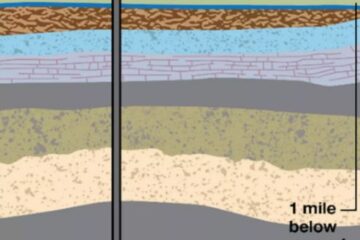New Mexico, Wyoming Know This Drill
When energy costs rise, coffers fatten. But the past has taught the states lessons about going on a $230-million spree.
Source of this article – Los Angeles Times, October 2, 2005.
By Nicholas Riccardi
Times Staff Writer
SANTA FE, N.M. — While legislators across the country are cutting programs to close deficits, this state’s lawmakers are to return to the Capitol here this week for a special session on how to spend some of their $230 million in spare change.
The windfall comes partly from the recent energy boom that has further dotted the West with gas rigs and coal pits, alarming environmentalists but pleasing state officials who have seen coffers fatten. The standouts in the boom are Wyoming and New Mexico, states that have received among the biggest infusions of cash and demonstrate two approaches to riding the West’s boom-and-bust cycle.
“We’re thankful to the rest of the nation for our good fortune and encourage them to keep consuming oil and gas,” New Mexico Finance Director James Jimenez said.
Royalties and taxes from energy extraction on public lands have helped energy-rich states from West Virginia to Utah through the tough fiscal times that have tormented most of the nation’s capitals.
In New Mexico and Wyoming, though, the focus is on how to spend a once-in-a-generation avalanche of public funds.
Saddled with an aging, declining population and haunted by memories of the early 1980s bust, Wyoming is hoarding its new wealth. It is investing in programs intended to keep young people in the state — such as a $400-million scholarship program for high school graduates who attend the state university or junior colleges — and in one-time projects such as a school building spree so massive it has run out of contractors.
New Mexico officials talk a grander game, proposing pre-kindergarten programs and health insurance for all children. They invoke former California Gov. Edmund G. “Pat” Brown and the state highway and University of California systems he built in the flush 1950s, which guaranteed the Golden State’s prominence for decades. New Mexico may be able to help its residents deal with soaring gasoline costs by using some of the surplus for rebates — which, along with looking into price gouging, will be the focus of the special session.
But even as the state rakes in tax revenue from energy exploration, Gov. Bill Richardson has proposed limiting drilling on some private and environmentally sensitive lands. Meanwhile, conservative activists are calling for a cap on government spending, arguing that taxpayers deserve the excess energy money.
“It’s a very pleasant predicament,” Richardson said in an interview.
New Mexico and Wyoming are in that fix because, with small populations and little industry other than energy, their fortunes rise and fall with the price of energy.
That means they miss out on boom times, such as the late 1990s, when low energy prices keep the national economy humming. But when power costs rise, the two states thrive. And with U.S. crude oil prices having peaked in August above $70 a barrel before easing some, analysts say the current boom shows few signs of receding.
New Mexico’s energy revenue has risen more than $400 million since 2002. Officials project that over the next five years they will have $1.1 billion in additional revenue, a total that includes money from rising corporate income taxes and other fees that are also juiced by high power costs.
Wyoming is doing even better. Its energy revenue has doubled since 2002, and it took in more than $1.4 billion this year. Wyoming is the nation’s least-populated state — with half a million residents — and its overall budget of about $3 billion is less than that of Los Angeles.
Although many energy-producing states have seen their energy tax revenue leap in recent years, Wyoming and New Mexico are in the company of energy giant Alaska, which returns revenue from oil and gas extraction to its citizens and is still running a $600-million budget surplus.
But the good fortune is a double-edged sword. Mike McVay, Wyoming’s budget director, cites a popular Wyoming bumper sticker that reads, “Lord, let us have another boom. We promise we won’t mess this one up.”
McVay and many others in the state remember the energy boom of the 1970s and early 1980s. “The mentality was very much, ‘Let’s ride this baby as far as it can go,’ ” said Ed Barbier, an economist at the University of Wyoming in Laramie.
In the early 1980s, the state Legislature passed yet another budget based on rising energy costs. Then the bottom dropped out of the energy market. The state cut 7% across the board, which included layoffs.
Over the next 15 years, Wyoming wages stagnated and unemployment skyrocketed. Young residents left the state. The Legislature had no cash for basic road or building maintenance.
Those problems are now reversed. Tax money is pouring in, the state has a $300-million school construction program and the government’s gains have spilled into the private sector. Wyoming’s 3.7% unemployment rate is below the national 5% rate.
But state officials are cautious. “What we’ve learned from this is to question the stability” of the latest boom, McVay said.
Wyoming officials have boosted to $12 billion the reserve fund where energy revenue normally goes. This long-standing fund has allowed the state to avoid levying an income tax for generations and will help fund programs after coal beds and gas deposits are depleted.
New Mexico also has reserve funds built by energy dollars that pay a set amount annually for public education. In 2003, as the energy boom began in earnest, newly elected Gov. Richardson pushed a constitutional amendment that upped the amount regularly drawn from this reserve by about $60 million.
That money paid for teachers’ raises and an education overhaul. Richardson says such programs will combat high rates of child poverty and poor school performance.
When budget projections continued to forecast more money, Richardson, a Democrat, announced that 2006 would be the “year of the child.” Richardson got a $5-million pre-kindergarten pilot program passed last year and vowed to get the entire package funded. That could cost three times as much.
His administration insists that not all new money is from energy. New Mexico has the nation’s 11th-fastest rate of job growth, and rising income tax revenue and escalating property values have contributed.
But conservative critics say the administration is spending money that may not always be around.
John Dendahl, a former state Republican Party chairman and president of the Rio Grande Foundation, a conservative think tank, has called for a constitutional amendment modeled on a Colorado measure that requires the state to return extra money as tax refunds.
Richardson, who cut the top tier of New Mexico income taxes and capital gains taxes, responds that residents have already gotten money back from the state. The state Legislature is controlled by Democrats, and observers agree that it is unlikely any Colorado-style spending limits will be enacted. Still, legislators are mindful that energy money could dry up.
The Richardson administration says that energy money has also been used to upgrade roads and sewers. One such project helped lure a mattress manufacturer to the Albuquerque suburbs. State officials say developments like this show the economy is diversified.
Richardson alluded to that diversification to justify his battle against gas exploration on federal lands in the Otero Mesa in southern New Mexico. The state has sued to block exploration beneath 1.8 million acres of federal land west of Carlsbad, citing environmental concerns.
The governor said his state needed to be mindful that its future lies in areas other than simply energy extraction.
“They want to drill anywhere they want,” Richardson said of energy companies. “There are some areas that require a balance. We also want to protect tourism and recreation.”


